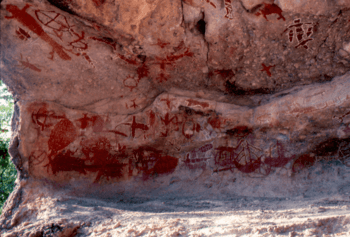Stanley Island facts for kids

The northern wall of Yintayin rock shelter
|
|
| Geography | |
|---|---|
| Location | Coral Sea |
| Archipelago | Flinders Group |
| Administration | |
|
Australia
|
|
| State | Queensland |
| Local government area | Shire of Cook |
Stanley Island is a beautiful island in Queensland, Australia. It is part of the amazing Great Barrier Reef Marine Park. You can find it near Cape Melville and Bathurst Bay.
This island is located north of Denham Island and Flinders Island. It is also part of the Flinders Group National Park in Princess Charlotte Bay. Many tourists love to visit Stanley Island because it has great places to anchor boats. Stanley Island became a national park in 1939.
The northernmost point of Stanley Island is called Cape Flinders. A ship named Frederick was wrecked there a long time ago in 1818.
Contents
Ancient Rock Art on Stanley Island
Stanley Island is very important for its amazing rock art. These artworks are part of the stories and beliefs of the local people, known as the Flinders Group's mythology.
The Ship Rock Shelter: Yintayin
The most famous rock art site on Stanley Island is a huge rock shelter called Yintayin. People often call it the "Ship" rock shelter. The walls of this shelter are covered with paintings of ships.
What the Ship Paintings Show
The paintings are made with red and white ochre on the red sandstone. They show different kinds of ships:
- Sailing ships that look like European lugger boats.
- Ships from Indonesia, called Macassan prau boats.
- A dugout canoe with a person standing up, arms outstretched.
Some people think that the paintings of European ships with high backs might be from the 16th or 17th century. This is interesting because the first European explorer to officially report seeing this coast was Captain James Cook in 1770. He was on his ship, HMS Endeavour.
Other Rock Art Sites Nearby
There are also similar paintings on nearby Castle Peak. These include a steamship and a very detailed picture of a lugger boat named Mildred, pulling a smaller dinghy. Another important site is Muyu-Walin, which is part of a big story cycle called Itjibiya.

